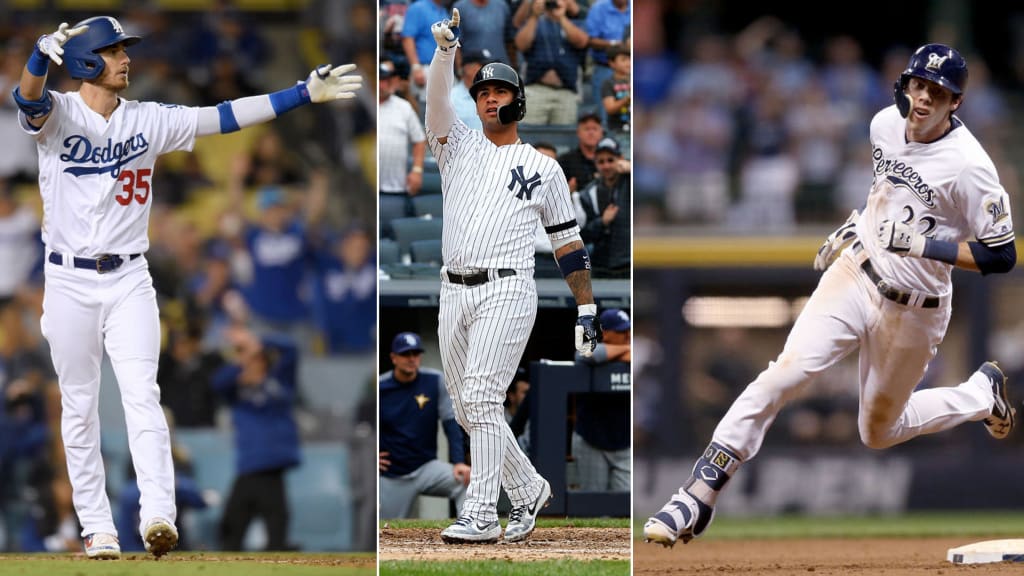
With the July 30 Trade Deadline fast approaching, plenty of attention will be focused on the players acquired by contending clubs and the impact they can make down the stretch.
Not every team with October aspirations, however, will be able to address needs by bringing in a new player via trade or by relying on the return of an injured difference-maker. How might those squads improve, then? By working with what they've already got.
In fact, a number of contenders have a big name who did not perform up to expectations before the break. If the following players can rebound in the second half, they could be the driving force behind a postseason push -- and then some.
Christian Yelich, OF, Brewers
First-half stats: .241/.399/.369, 5 HR, 24 RBIs in 59 games
The Brewers are in first place despite Yelich totaling only 13 extra-base hits and slugging .369 through the first half. That seems almost impossible, given how important the 2018 NL MVP was to Milwaukee in '18 and '19. No doubt, Yelich's back injury has limited both his performance and his playing time, and at least he was getting on base at an elite .399 clip.
But for the Brewers to put the rest of the NL Central in the rearview mirror and become a feared October opponent, the offense is going to need to pick it up -- and that starts with Yelich, who is the one Milwaukee hitter who can claim "superstar status" on his resume. For that to happen, Yelich may need to eschew his premier patience in favor of some old-fashioned aggression, especially early in the count. Consider: During his MVP-caliber campaigns, the lefty slugger swung at first pitches almost 30 percent of the time, whereas that plummeted to 13.4 percent last year and is only at 22.0 percent this season.
If hurlers start fearing him less and attacking him more, the 29-year-old Yelich will need to prove that his balky back is better by jumping on early offerings and doing damage. Maybe his July 18 homer -- an opposite-field blast on a 1-0 pitch from a southpaw -- is a sign there's some more power in store.
Cody Bellinger, OF, Dodgers
First-half stats: .176/.291/.303, 4 HR, 17 RBIs in 34 games
It's wild to think that the two most recent full-season NL MVPs -- Bellinger in 2019 and Yelich in '18 -- are in almost the same boat more than halfway through the season, fighting injuries and inconsistency. And yet, both of their teams still are occupying playoff positions.
Bellinger faced a difficult recovery from a hairline fracture in his left fibula that kept him sidelined nearly two full months, so it's hard to be too tough on the 26-year-old's lack of production to this point. In some respects, his season is just a very small sample size. What's slightly worrisome, however, is that Bellinger has had a very rough July with a .336 OPS -- albeit with a .103 BABIP in a mere 63 plate appearances -- after appearing to get on track in June (.827 OPS in 62 trips to the plate).
The preseason consensus was that the Dodgers would run away with the NL West, and yet they find themselves in a three-team battle with the upstart Giants and tenacious Padres. As stars like Clayton Kershaw, Mookie Betts, Corey Seager and others look to recover from their own injuries, the Dodgers' run of eight straight division titles -- the longest active streak in the sport -- could come down to whether Bellinger can get right. Lowering his career-high 27.0 percent strikeout rate by improving his career-worst 29.3 percent chase rate could help him turn it around.
Blake Snell, LHP, Padres
First-half stats: 4.99 ERA, 1.55 WHIP, 10 HR allowed in 70 1/3 IP
Sticking in the NL West, Snell has shown flashes of dominance over an inning or three within many of his outings, but he's been unable to maintain that form over any extended stretch, pitching at least six innings only twice in his first 17 starts. That qualifies as disappointing so far for a Padres team that paid a steep prospect price to add the 2018 AL Cy Young Award winner to their win-now window.
The biggest culprit for Snell has been his command and control -- or lack thereof. While he's had occasional issues finding the plate in the past, his current 14.1 percent walk rate would be a career-worst mark. Combine that with some bad luck (.330 BABIP against), and the 28-year-old finds himself in a precarious position.
With Chris Paddack struggling and Dinelson Lamet and Ryan Weathers out with injury, the Padres need Snell to find his form, especially with his offspeed stuff -- his curveball sports a .366 xwOBA and his changeup a .388 mark -- and form a potent 1-2-3 with Yu Darvish and Joe Musgrove. The good news? Snell still is sitting in the mid-90s with his fastball and striking out 28.2 percent of batters, but better command would mean more consistency and more high-quality innings.
Gleyber Torres, SS, Yankees
First-half stats: .240/.326/.308, 3 HR, 29 RBIs in 77 games
Frankly, it's fair to wonder if the Yankees even qualify as legitimate contenders given that they reside in third place in the AL East and haven't performed anywhere near preseason projections. There's no shortage of candidates to consider when it comes to the Yankees' offensive woes this year, but Torres has seen his stock drop more than any other pinstriper. This is a 24-year-old former top prospect who looked ready to blossom into a star after his breakout 38-homer campaign in '19.
Even if that output was somewhat unexpected -- and remember, a whopping 13 of those dingers came against the Orioles' pitching staff -- Torres' lack of pop since the start of '20 is bewildering. One explanation? His 86.6 mph average exit velocity this season ranks in the eighth percentile of baseball and his hard-hit rate (34.4 percent) is a career low.
On the plus side, his strikeout (19.8 percent) and walk (11.9 percent) rates are indicators that Torres' plate discipline is in shape. It looks like he could benefit from a boost against fastballs: He has a .286 wOBA and .327 xwOBA against that pitch this season after posting much higher marks the three years prior. Homers in consecutive games in the second half-opening series against the rival Red Sox -- including one on an 0-2 fastball -- might spark a surge.
Eugenio Suárez, INF, Reds
First-half stats: .175/.256/.372, 18 HR, 50 RBIs in 86 games
The Reds entered the second half as somewhat surprising contenders considering rotation stalwarts Luis Castillo and Sonny Gray had their share of struggles before the break. Add in Suárez's showing, and the fact that Cincy is in second in the NL Central is that much more of a surprise.
The experiment of putting Suárez back at shortstop -- the position at which he made the Majors -- proved to be a failure, as he struggled both defensively and offensively. Thing is, since returning to the hot corner in late May, the 30-year-old hasn't done much better with the bat (.628 OPS vs. .616 through May).
After crushing 49 taters in '19, Suárez struggled to start last season, too, in part due to offseason shoulder surgery, but he eventually turned it around. The Reds are going to need him to flip a similar switch and go from sluggish to slugger, joining Nick Castellanos and Jesse Winker over the final two-plus months if they hope to solidify a playoff berth for a second straight season. (If Castellanos' right wrist injury is serious, the Reds will have to rely even more on Suárez.) He still is capable of hitting homers and his .195 BABIP is unsustainably low, but Suárez must cut down his strikeout rate (career-high 30.1 percent) and hit more liners (career-low 19.7 percent).
Aaron Nola, RHP, Phillies
First-half stats: 4.53 ERA, 1.21 WHIP, 15 HR allowed in 101 1/3 IP
At 44-44 through the first half, the Phillies qualify as contenders primarily because of their division. The NL East has underwhelmed, leaving the door open if Philly -- which has been within four games of .500, either way, all season and has yet to have a winning streak longer than five games -- can get going in the second half. For that to happen, it just might take the 28-year-old Nola putting it together down the stretch with Zack Wheeler atop the rotation, particularly since Zach Eflin currently is sidelined.
After emerging as an ace in 2018, Nola followed that up with consistent production the past two years, but he's having a rather odd 2021. His 29.0 percent strikeout rate ranks as the second best in his career behind his 33.2 percent mark from last year's shortened season, and his 5.3 percent walk rate is his best to date. And yet, Nola's 4.64 ERA is his highest since 2016, when he endured a season-ending elbow injury.
Part of the problem is some misfortune on balls in play, as his .330 BABIP allowed is the fourth-highest among qualified starters. Eflin and Wheeler also sport high BABIPs, which can be attributed to the Phillies' shaky defense -- their minus-15 Outs Above Average as a team is tied for fourth worst in MLB. In other words, this isn't entirely on Nola, but he would benefit by lowering his career-high 27.6 percent fly-ball rate, which has contributed to a career-high 1.4 HR/9 mark. If the Phillies are going to end their 10-year playoff drought, Nola needs to get back to being a reliable workhorse.
Michael Conforto, OF, Mets
First-half stats: .202/.345/.301, 3 HR, 19 RBIs in 52 games
After a huge 2020 in which he slashed .322/.412/.515 for a career-best 154 OPS+, this is not how Conforto envisioned his walk year going. He got off to a slow start that was compounded by a right hamstring injury, which wound up costing him 34 games. Since returning June 23, however, the 28-year-old has recorded a mediocre .724 OPS.
The drop in pop before the break was most noticeable -- Conforto slugged just .301 -- but his xSLG for the season is .438, and he's picked up the pace to a .490 SLG in July. Meanwhile, his xWOBA of .365 is not far off his .374 mark from a year ago, and Conforto's walk (a career-high 13.9 percent) and strikeout (23.3 percent) rates are proof that his approach is in place.
That could portend production the Mets would welcome in a lineup that is lacking a healthy Francisco Lindor and also has seen others, like Dominic Smith and Jeff McNeil, fall shy of expectations. If Conforto is going to help the Mets hang onto first place in the division -- not to mention, rebuild some of his market value heading into the offseason -- he'll have to show he can get back to slugging some more down the stretch. Like, say, the three homers he hit over a recent two-game stretch to open the second half.
